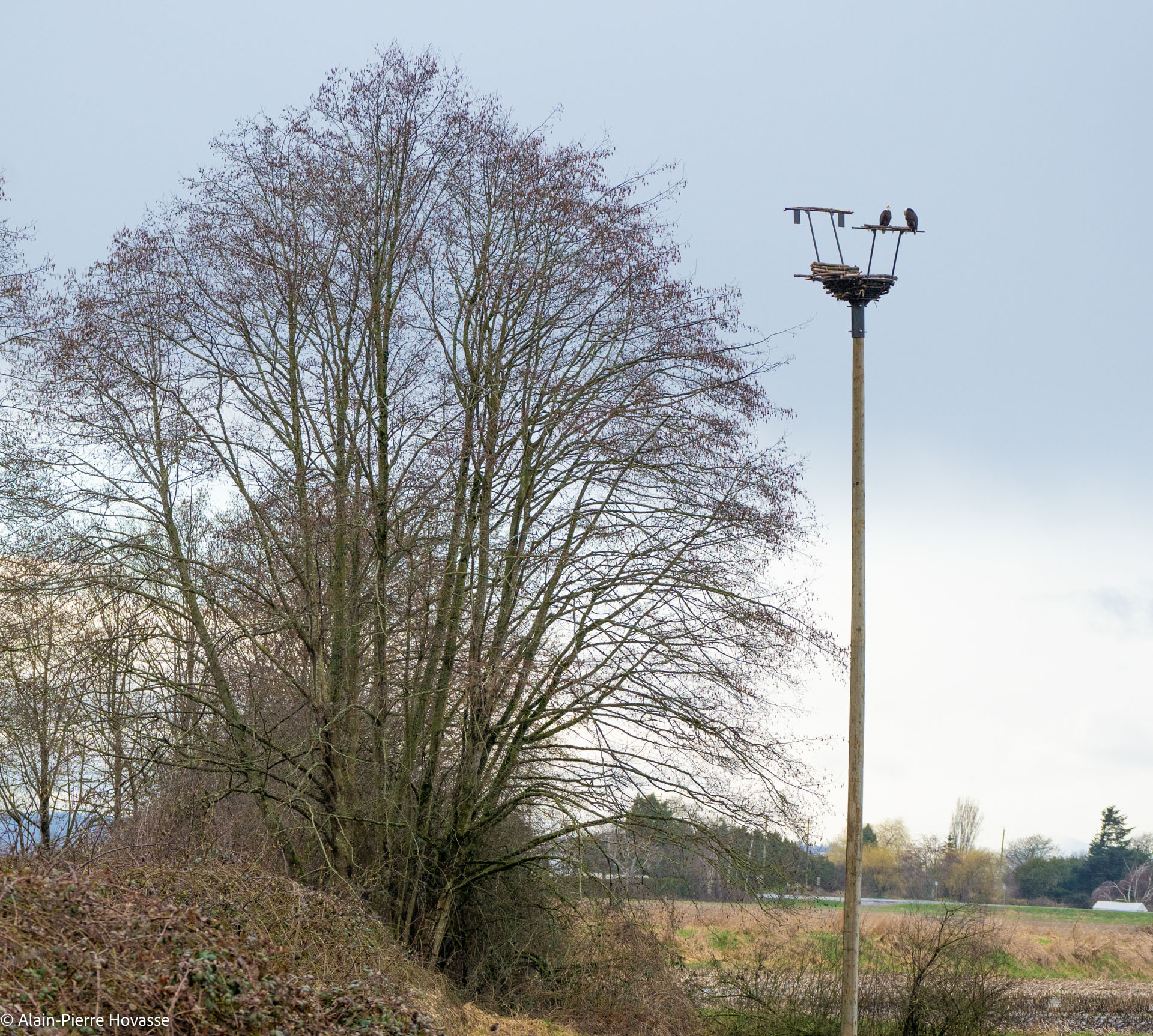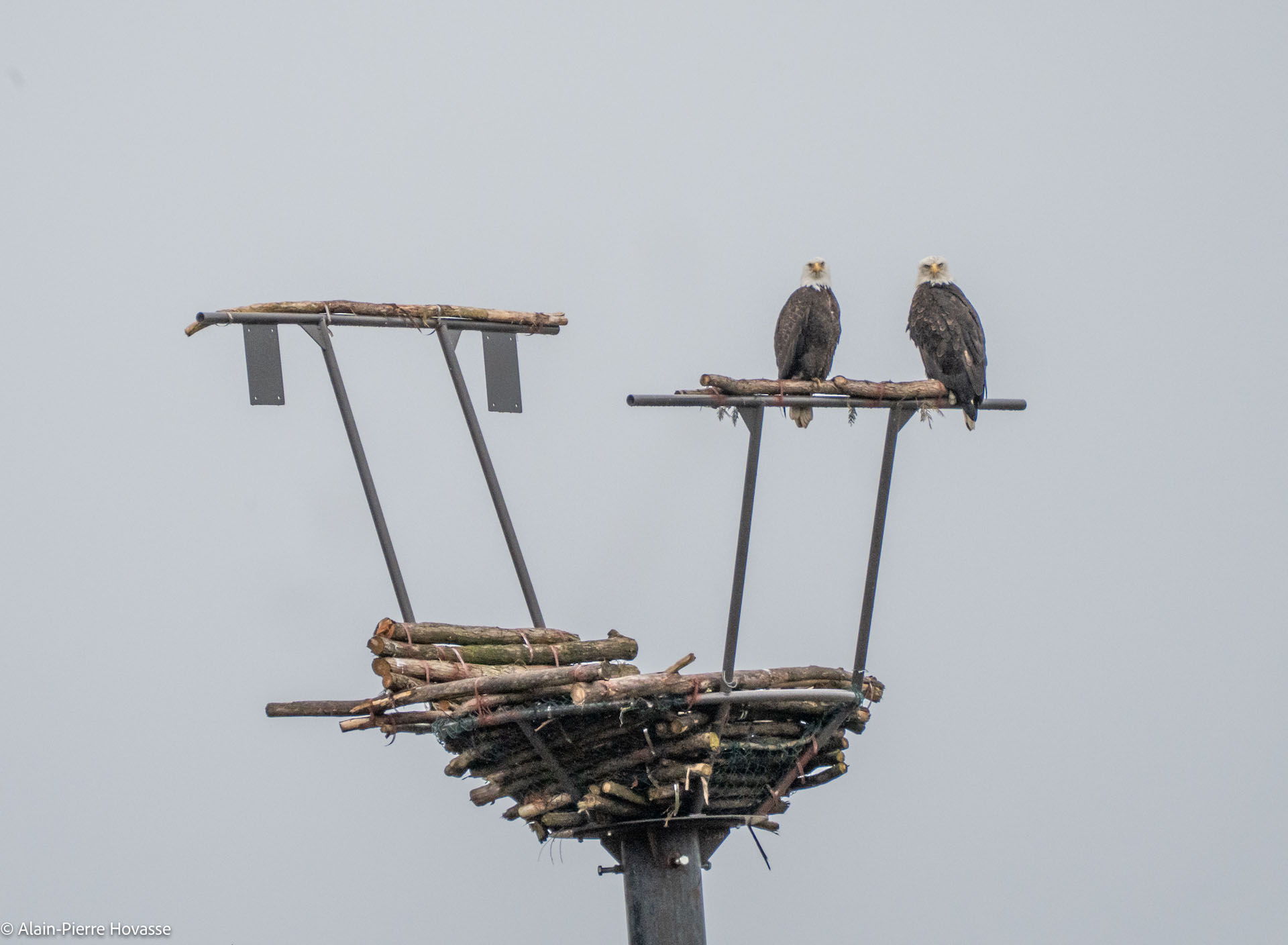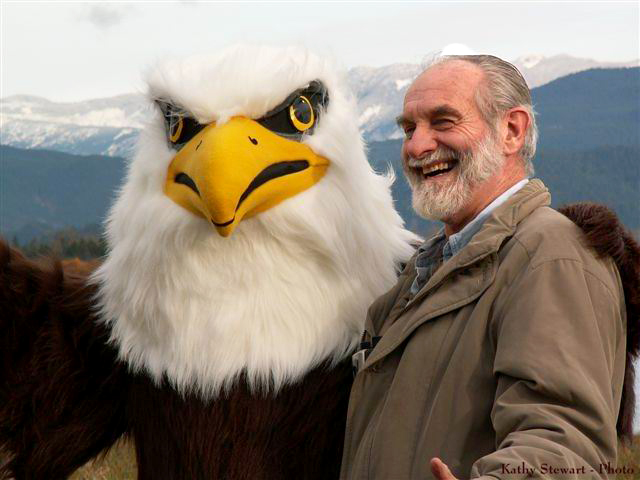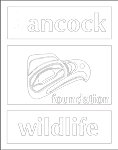Hi All,
Abstract:
Big eagles need big trees to hold big nests! The problem is the lower mainland, and many other areas, have few big trees left beside the food producing waters where eagles most successfully rear young.
Many of the hundreds of nests we survey on a regular basis are placed in inadequate trees: thin trees whose supportive branches frequently break off and fall or are too close to the ground and human disruptions.
Delta-2 Bald Eagle nest, April 2022: propped up and about to fall — it and many others need your help.
This is our Hastings Park nest: left, with rough-frame in place & on right with smaller branches filled in. Only the greenery is to be added – largely by eagles!

A few months later the pair successfully reared 3 young. Thanks Vancouver Parks for making this happen. Images: Vicki Kahri & Diana & Mike Seear
Better nest supports are needed in many Bald Eagle breeding territories. But we need your help. We have raised just over $10,000 so far with this GoFundMe campaign and we need at least that much more to raise the Delta-2 pole and nest installation. We can rebuild a new nest in an existing tree for under $5,000 but no such trees exist in this pair’s territory. Please donate to the Bald Eagles. If we get additional funds, we will build more nests, perhaps in your area. The HWF is managed by volunteers that ensures 100% of the funds raised goes to building nests and studying these eagle needs.

Another new bald eagle pole & nest, Delta BC.

Closeup with two new resident owners. Each new nest this year will have a 1.2 m high overhanging sunshade to prevent overheating.
There is no doubt, your emotional and financial support of our eagles, or your own local eagles, will bring you good feelings and satisfaction for contributing to what makes Super Natural British Columbia both super and natural. And if you live elsewhere and want an eagles nest, well, give us a call and we will try and make it happen.
Details and Background of Hancock Wildlife Foundation Educational Outreach and Research. – David Hancock April 9, 2022
Back in 2006, the week we started the not-for-profit Hancock Wildlife Foundation, we also launched the world’s first live streaming eagle CAM. Now 16 years behind us I am now pondering an even more frightening adventure. I am dipping my toes into the world of “social media maelstrom”. Has my sanity been lost! Of course, everybody in the world deals with FaceBook, Twitter, and the like – that is everybody but me. I have only rarely ever been to any of them. Oh, HWF has Facebook, YouTube etc. accounts but these are managed by the volunteers.
However, at the release of the live streaming CAMS I spent three years doing nothing else but cater to the public’s questions. I loved answering the thousands of questions, writing up hundreds of “eagle biology summaries” – all many dozens of times — sometimes dozens of times the same day. I was burned out. I have now stepped back and only answer new questions arranged by our key monitors. Thanks monitors. And since 2010 social media has taken on a sinister element of nonsense that I find hard to handle.
The question became: Where do I spend my time, repeatedly answering the same questions or getting back to eagle research. Then at 70 and now at 84 the decision is even simpler – I want to follow our eagles – that requires I catch them, band and put on the trackers. I want to understand where our huge migrating population of eagles comes from – and our breeders and the fledglings go.
I also want to continue developing our understanding of eagle tolerances to humans. In particular, I wanted to perfect how to best build them new nests. This practical issue means trying to rebuild their habitat to again accommodate them in much of their most productive habitat. That priority habitat borders the shoreline and presents some huge challenges. The most productive breeding habitat is also the prime human habitat. Our first human priority is to take down trees!!!
So guess what is missing — other than the eagles — in prime eagle habitat the missing element is the big trees that hold up their huge nests. Quite naturally humans exploited new areas of North America from the rivers, lakes and oceans. These shorelines of course are the best eagle breeding habitats. Well, best not just because of the presence of food but because these shorelines were where the big gnarly-branched trees grew. Finding a crotch that an eagle can deposit a 2 to 3 pound branch across to start a nest is challenging. Of the thousands of miles of shoreline I have aerially surveyed for nests from Oregon, Washington, British Columbia and Alaska, I have seldom ever in wilderness areas seen a nest more than 100 feet from the water’s edge – and many nests hang over the beach. When eagles nest away from the water’s edge, it is because they could not find a suitable tree hugging the shoreline.
Beaches are people-places and where we first cut down the big trees for construction and then for building homes. The eagles, at those early times were unwelcomed scavengers and considered competitors. Now Americans are no longer shooting eagles for $2.00 a pair of legs. (for that story!). In fact our eagles have gone from vermin to conservation icons during my lifetime. So how do we now “rebuild” big trees to hold their huge nests?. This was first my unplanned research, then a key area of study to find practical solutions. We now build eagles nests in prime eagle habitat wherever we get permission and the necessary funding. We have learned how to build nests eagles love. More importantly, they readily use our nests rather than build their own nests in a poor tree. Smart, adaptable. This Go Fund Me project is about building eagle nests in both British Columbia and in North American backyards.
Now, we can address some ways to build nests more efficiently and effectively. That is what prompted this reflective review. We have built dozens of new nests for eagles — and I would proudly say we do a better longer lasting job than they do! So many eagle nests don’t stay in the tree for a single season. In fact I saw four nests get built in one season, with each nest simply falling out of the tree as the nest grew and finally lost its balance and toppled to the ground. With no other trees and optional tree crotches they kept trying in the same inferior crotch. After seeing the fourth nest fall in late June I knew it was too late for another try. Wrong.
Eagles are persistent. Late that November I was driving past this nest territory on the way to the Victoria Ferry. There across the street from where I had seen four nests fall, was a new nest, on top of an horticulturally introduced spruce tree. This 5th nest had 3 huge eaglets peering down! After waiting 3 hours in the Ferry lineup to finally be sent home because of the fierce winds postponing the ferry sailings I again passed the nest tree. To my shock the tree had blown over in the same storm and all three chicks were dead on the ground – still warm but dead. Five unsuccessful nests in one season. But how and why?
The answer is simple. The why, is that eagles are born survivors – they keep trying. The how is basically similar. Normally, in the best eagle breeding habitat of the country the key ingredient, big trees to support a big eagle nest, are abundant. Now they are not! Humans have changed that. We like shorelines and we don’t like trees in the road. Slowly I got to reinforcing some of the nests in inferior sites. Then I started to build new nests in bigger trees that simply did not offer the right crotch structure for the eagles to effectively start and then hang their nests. This proved instantly successful. I am not disillusioned. My nests fulfill the basic needs of nesting eagles. But they chose my nest because they could not find another higher tree with adequate branch structure to hang their own first branches to start a new nest.
We already knew that we should only enter an eagles nest while the eagles are off on migration — and not watching us. Now with the government having watched our efforts and understanding the importance of the timing we have built dozens of successful nests. Many of these are to replace nests that had to be removed for road interchange offramps or large industrial developments. Now our nest building has become a regular tool of “Best Management Practices”. If you have to remove a nest you have to provide a Mitigation Plan to replace it with 3 nests. Today’s developers need to pay a small price for past developers neglect.
The challenge we now face is so much of the prime nesting habitat is fully developed and the big trees are already long gone. This key nesting habitat is along the shorelines where the eagles want to nest, where food is readily available and quickly accessible. We have learned to supplement inferior trees with artificial nests or erect poles with nests on top. The eagles are happy. And neighbors love it.
If a developer has to remove a nest for a main road, dock or construction project, we determine where in that bird’s territory we can build either an artificial nest in a tree, or where there are no trees, we build a nest on a pole. Once we got to set the dates for when the active nest was removed and when we got to erect the alternative nest, we had 100% occupancy of our nests. We have not lost an eagle territory or delayed a year’s productivity. Home position is about location, location, location. When the issue is ‘When should an eagle move? It is all about timing, timing, timing.
Now we take satisfaction in predicting that the eagles will be occupying our new nest within 2 days of returning from migration. Our nests are likely good for up to 25 or more years: poles and nests perhaps double that. Sometimes we have to build temporary nests that may only last a few years. The Mosquito Creek Nest was such an exciting option.
So how does “Building eagles a new home” relate to our introduction of live streaming cams. It is pretty straight forward. Following our introduction of live streaming eagle cams to the world, CAMs popularity coincided with the introduction of mass media – the likes of Facebook, YouTube, Twitter etc. Then came the introduction of Go Fund Me projects. I have been slow to coordinate mass media promotions with our CAMs. That was an error on my part, particularly since my life is about education. But let’s not cry over spilt milk. Now I am wanting to catch up – the eagles need it!
Today we are planning on using our bald eagle’s plight, their loss of suitable homes, our ability to give them alternative nests, as a lever to raise funds to continue building them wonderful homes. First, you need a productive shoreline where trees are sorely lacking. Then with our learned skills we simply build them better nests. Just as we supported the introduction of CAMS across the USA we wish to popularize the rebuilding of eagle nests in big trees across the best bald eagle breeding habitat of North America. Come to think of it, my early 1960’s pioneering breeding of captive peregrine falcons with Frank Beebe helped lead the way to the world’s release of peregrines—so why not start another trend. If you live in good bald eagle habitat “Would you like an eagle’s nest in your backyard?” Give us a call!
Our volunteers have decided to promote a Go Fund Me “Bald Eagle Nests Desperately Need Your Help”. Our website documents many of the artificial eagle nests we have built.
A reflective pondering: “How a world event was shaped.”

David Hancock & ‘Harrison’ our Fraser Valley Bald Eagle Festival Mascot.
I started to query my senses in now returning to ‘social media’ when I have refused to get involved with Facebook etc. earlier. Then I was reminded: “Hancock, you created the world’s largest ‘mass media following for any website in 2006, according to the executives of Microsoft, who jumped in to help us reach 55 million viewers that first year!”
I was asked “How did we get more followers to our web site than the Pope that year?” It was simple and a natural advertising event. The week we were going to attempt to live stream the eagle nest I was pre-scheduled to be in Antarctica. I wrote a brief story observing Ma eagle “moaning 9 times and then looking down at a newly laid egg between her legs” Until our web CAM, I had never seen and heard how eagles go into labor. Every woman instantly identified with this example. I described the opportunity of anybody now being able to view the CAMS and do a detailed study of eagles – a perspective never before witnessed by biologists or naturalists. The intensity and drama of watching a weak little wet wild creature emerge from between the two halves of the just opened shell was a new experience to the world.. Within hours of my email release the dial-up services (Yes- remember them!) of Microsoft were taxed well past their limits.
Tomorrow was different. They released another of our live stream signals from their central pipes in Chicago. Here they had the world’s largest bandwidth available — and they were right. We did not blow their system until nearly 2/3 of a second into transmission — simple more simultaneous connection attempts than Microsoft had ever planned for. Over the next week, the news outlets of the world were calling me every few minutes. I did some 5 to 17 international interviews per day. Microsoft and our techy solved the distribution challenge over the next couple of weeks. But that was only part of the story of having developed the world’s largest web site.
There is one element and one person who has not received full credit for really making it happen. One person really popularized Live Streaming Bald Eagle Nests – or wildlife streaming CAMS in general. That is George Kotsiopoulos, the CBC summer evening news anchor replacement for Peter Mansbridge. Every evening, in the middle of the Evening 6 PM News – repeated other times across many networks, George, thereafter known to me only as Mr. Eagleopoulos, broke into the evening News by stopping his regular delivery, holding up his hand demanding world viewer attention, getting up and walking over to a large TV monitor on the stage a few feet away and saying “I must check up on the nesting eagles in Sidney”.
The news rooms of the world, all of which carried a little CBC monitor next to the BBC, ABC, CNN and RT monitors, went wild. What was the National News anchor going to point out? That is what prompted the 5 -17 international interviews per day for weeks. Literally the world was “trying to watch” our Sidney eagles feed their little chicks. Each news cast was repeated by other news units around the world. These news reporters called me. That made our web site the most viewed website in the world for nearly two years. I often wondered if it was because we are a not-for-profit organization that they did not mind giving us a million dollars of free publicity. I heard from old friends, authors and fellow biologists from around the world. Our Sidney eagles were an international phenomena.
George – Mr Eagleopoulos — you created a world-wide trend, and I thank you. I am sure that some of the new media cheered, some groaned! From that moment on every TV station in the world started to broadcast their own streaming news channel, every naturalist, and some promotion oriented individuals, started broadcasting their local eagles and other wildlife streaming to a waiting audience. Certainly, other people had broadcast live streaming wildlife a few months earlier but they had not captured the world’s attention – that unique record went to our bald eagles and their growth pains, and their intimate moments.
So between our Hancock House Publishers 43,000 email list of raptor scientists, authors, falconers, researchers, throw in a few thousands of parrot, crane and softbill breeders and George Eagleopoulos’s full distribution of the signal to the world’s News rooms, wildlife and public education got a tremendous boost. Totally wonderful. Thanks George.
So, I summarized this story to give me confidence to again tackle the news media, this time also the social media, the Facebooks, Twitters, and the like, to again bring help to our stressed eagles. Please pass along our eagle nest plight to your contacts — a ‘like’ or a ‘friend’ or a ‘follower’ –perhaps your neighborhood eagles need a home!
I have to say again: There is no doubt, your continued financial and emotional support of our eagles, or your local eagles, will bring you good feelings and satisfaction for contributing to what makes Super Natural British Columbia both super and natural. And if you live elsewhere and want an eagles nest, well give us a call and we will try and make it happen.
David Hancock Biologist, Call or email me: 1 604 761-1025 davidhwf@gmail.com
Hancock Wildlife Foundation. To follow our Live CAMS or our Tracked eagles go to: www.hancockwildlife.org




